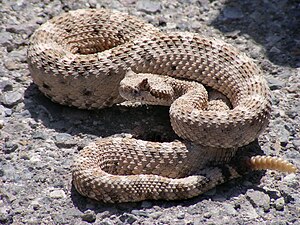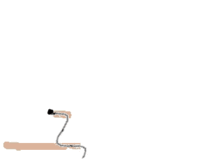Sidewinder rattlesnake
| Sidewinder rattlesnake | ||||||||||||
|---|---|---|---|---|---|---|---|---|---|---|---|---|

Sidewinder rattlesnake ( Crotalus cerastes ) |
||||||||||||
| Systematics | ||||||||||||
|
||||||||||||
| Scientific name | ||||||||||||
| Crotalus cerastes | ||||||||||||
| Hallowell , 1854 |
The sidewinder rattlesnake ( Crotalus cerastes ), also sidewinder or horned rattlesnake , also known internationally as the sidewinder after the English name , is a type of rattlesnake that is common in the southwest of the USA and in northern Mexico . With a maximum length of about 70 centimeters, it is a medium-sized species. It is known for its eponymous mode of locomotion, the "cross winds ".
features
The sidewinder rattlesnake reaches a maximum body length of around 70 centimeters, whereby in contrast to all other rattlesnake species, the females are slightly larger than the males. The physique is bigger and more compressed than that of the other rattlesnakes. The body color is adapted to the ground and ranges from a cream-colored tone to gray and yellow-sand-colored to pink tones. The back side is provided with a row of spots, which is usually a little darker than the basic color and also varies in its color and shape, with spots in between that are lighter than the basic color. There are usually also darker spots on the flanks.
The head color corresponds to the basic color of the body, over the eyes a darker stripe extends into the corners of the mouth. The super-eye scales ( supraoculars ) are elongated and form a clearly recognizable and pointed horn above the eyes, this formation is unique within the rattlesnakes.
The tail has four to six black and white bands, each about the same width. The tail rattle in this species usually consists of only a few limbs and is correspondingly short.
distribution and habitat
The sidewinder rattlesnake lives in the deserts of the southwestern United States and northern Mexico, from Baja California to the Gulf of Mexico in Texas . They can also be found on the island of Tiburón in the Gulf of California .
It lives exclusively in very dry habitats in the desert, often around dunes. It prefers sandy areas and even if it sometimes occurs on gravel beds, this is usually in the vicinity of sandy, dry river beds or other sandy areas.
Way of life
Like most other species of rattlesnakes, this species is also primarily active at night and at dawn and lives exclusively on the ground. It feeds mainly on small mammals , more rarely on lizards or birds, which it kills with its bite. If there is a potential threat, the snake tries to flee or digs itself into the sandy bottom very quickly. If the threat becomes more intense, the snake can use its rattle as a warning, making a loud rattling noise.
With the so-called cross winds, the sidewinder rattlesnake has implemented a special type of locomotion that is only found in a few species that live in deserts, which gives it its name. It moves sideways at a 45 degree angle across the sand, always rolling at two points with the entire body. The head is put on and rolled off, the entire body follows it, while the head is already touching down in a new place. This type of locomotion creates typical J-shaped tracks in the sand.
Like all rattlesnakes, this species can use the pit organ to track down prey based on its heat radiation, which enables hunting even in complete darkness. Because of this property, the Sidewinder rattlesnake was named after the AIM-9 Sidewinder , a heat-seeking air-to-air missile , which was developed on a base in the range of the animal.
Snake venom
The sidewinder rattlesnake has a typical rattlesnake venom with hemotoxic effects. So the main part of the poison make up proteases and phospholipases . As a comparatively small snake, the amount of poison injected when it bites is quite small, so that it is generally not counted among the particularly dangerous rattlesnakes.
literature
- Chris Mattison: Rattlers! - A natural history of rattlesnakes. Blandford, London 1996. ISBN 0-7137-2534-6
- Dieter Schmidt: snakes. Biology, species, terraristics. bede publishing house Ruhmannsfelden 2006. ISBN 3-89860-115-3
Web links
- Crotalus cerastes in The Reptile Database
- Crotalus cerastes onthe IUCN 2013 Red List of Threatened Species . Posted by: Frost, DR, Hammerson, GA & Gadsden, H., 2007. Retrieved October 2, 2013.
Individual evidence
- ↑ Ron Westrum: Sidewinder . Creative Missile Development at China Lake. Naval Institute Press, 2013, ISBN 978-1-61251-363-8 , chap. [5] - Fox Sugar 567 (English, limited preview in Google Book Search).



